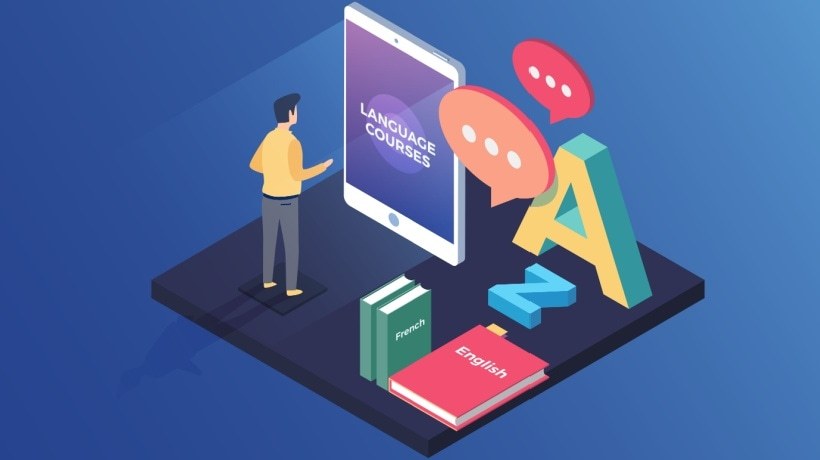How Language Training With eLearning Can Bring A Better Student Experience Through Technology
Today, it’s not uncommon to hear of someone firing up a laptop and attempting to learn a new language once the workday is done. Thanks to the myriad online programs designed to facilitate such advancement, this type of continuing education can be journeyed from the comforts of home, and has been available on this type of platform for years.
For all of this accessibility, foreign language enrollment numbers continue to decline, dropping 9% in only three years. While nearly 1.75 million students were enrolled in a language other than English in 2005, that number is down to less than 1.50 million students today.
One reason for this downtick? For some time, distance learning and foreign language education have been synchronous with slow loading times, clunky page layouts and pixely graphics. Now? The software and applications of the old are traditional and even rudimentary compared to the more modern, technologically advanced solutions on the market today.
Now, the ease of access and usability associated with modern eLearning systems makes it easier than ever before for students to successfully complete the language training. Integrated tools that facilitate online study habits, cross-team collaboration and professor communication are more than partially responsible for this uptick in engagement.
While the benefits are clear from a student standpoint, how does the evolution of eLearning affect language teachers? The answer is multifaceted and worth exploring. As in-classroom instruction wanes in favor of more remote, digital classwork, is the professor, whose job in this niche is so centered on face-to-face interaction, facial cues, hand gestures and more, helped or hindered by this transformative shift?
As the role of a language instructor continues to morph from one of hands-on mentor and tutor to one of facilitator and motivator in response to the proliferation of technology, it is this very issue that we’re exploring, taking a dive into what these professionals can expect to gain by embracing the eLearning trend.
More Accurate Student Monitoring And Assessment
In-person communication can help guide professors toward which students are grasping the concepts and which are having a more difficult time. For instance, those who raise their hands and answer questions the most frequently are assumed to be those with the clearest knowledge, yet this is not always the case. Relying on such interactions alone to monitor and assess a student’s recollection level can leave a professor falling short of truly understanding and best mentoring his or her students.
Conversely, an eLearning platform, or a Learning Management System (LMS) will have built-in software functionality that makes the review process as efficient and accurate as possible. Professors can analyze performance on both an individual student level, as well as on a group level, then quickly compare the two. From there, weak areas are highlighted, as are any issues that need addressing.
Especially if the language course is a hybrid eLearning/in-classroom design, the instructor can then use that data to facilitate a more efficient and targeted discussion time when the class meets together again, armed with the knowledge around which specific topics require further exploration.
Built-In Community Encourages Interaction
Learning a new language or becoming more proficient in one is often a solo task that requires repetition, practice and consistent review and testing. Yet, studies reveal that learning is a collaborative and social effort, and that quality learning takes place in groups. Therefore, there must be a tool in place to encourage students to work together, solve problems and find new avenues for exploration alongside one another.
This is where an eLearning platform can best be utilized. Through features including integrated Frequently Asked Questions (FAQs), chat rooms and communities, access to online language resources, virtual hangout rooms and more, collaboration is both encouraged and facilitated. Moreover, it’s available across time zones and geographical barriers, partnering together persons who may have otherwise never met due to such restraints.
This is an especially important factor in the case of foreign language education. This is an area of study that is facilitated best by back-and-forth communication. When eLearners participate in virtual study groups, they can see, hear and learn from students all around the globe, challenging and stretching their communication skills and ultimately, helping them to hone them.
These resources also make it easier for students to communicate in real time with their professors on any issue that requires resolution or questions they need to be cleared up. Email management options available on most systems mean that professors can receive, send and prioritize messages with a few clicks.
The Ability To Create And Adjust Course Content
By pairing an LMS with a Shareable Content Object Reference Model, or SCORM, a language instructor can turn it into a Learning Content Management System, or LCMS. From here, the ability to customize course content is maximized, meaning that the instructor can create new courses, decide whether or not to integrate virtual classrooms into it, design tests, generate surveys, write quizzes and Q&A sessions, and more.
In this way, though the course in question might have pre-loaded language exercises, it’s improved and expanded tenfold through customization. This helps professors tweak and adjust their content, especially as they continue to monitor and assess performance throughout the life of the course.
More Efficient And Valuable Use Of Instruction Time
When an LMS is utilized, an instructor can choose to customize it as detailed above, or rely primarily on its integrated courses and modules. In the case of the latter, the myriad hours of planning and organizing course content can then be redirected back into the learning experience itself. Without the burden of paperwork to sort through and designs to try, the instructor can invest that energy back into the classroom. They’re also less susceptible to teacher burnout, which can be emotionally, physically and mentally draining.
At the same time, the instructor is able to relate to the language students on a more individual level, adopting the persona of mentor or advisor as students work through the course materials, rather than strictly a lecturer. As this occurs, he or she can begin to best understand each student on a pedagogical level, adjusting the delivery of instructional materials, if required, to meet each one where they are.
According to research, college students expect their technology experience to be personalized and connected. In fact, 47% of them wish that instructors would offer curriculum and coursework based on their individual performance. Though it might not be a viable solution with every student, when a language instructor leverages an advanced LMS, it’s possible.
Leveraging eLearning As A Language Instruction Tool
The advent of eLearning means that language instruction can be as dynamic and full of discovery as possible. As routine programs and processes are replaced with interesting and collaborative online interactions, student morale is boosted and professors are encouraged, as well.
Moving forward, forward-thinking language centers and instructors will be those that embrace eLearning platforms and utilize them to supplement or even entirely replace their classroom-based instruction. The key to a successful implementation is to consider student needs, assess the available technology and decide from there which options are best suited for your effort. When learning is both fun and challenging, it’s more likely to stick, and with this platform, both hold true.









